

 |
 |
Ahmad Abu-Al-Aish and Steve Love
Brunel University, UK
M-learning will play an increasingly significant role in the development of teaching and learning methods for higher education. However, the successful implementation of m-learning in higher education will be based on users’ acceptance of this technology. Thus, the purpose of this paper is to study the factors that affect university students’ intentions to accept m-learning. Based on the unified theory of acceptance and use of technology (UTAUT) (Venkatesh et al., 2003), this study proposes a model to identify the factors that influence the acceptance of m-learning in higher education and to investigate if prior experience of mobile devices affects the acceptance of m-learning. A structural equation model was used to analyse the data collected from 174 participants. The results indicate that performance expectancy, effort expectancy, influence of lecturers, quality of service, and personal innovativeness were all significant factors that affect behavioural intention to use m-learning. Prior experience of mobile devices was also found to moderate the effect of these constructs on behavioural intention. The results of this research extend the UTAUT in the context of m-learning acceptance by adding quality of service and personal innovativeness to the structure of UTAUT and provide practitioners and educators with useful guidelines for designing a successful m-learning system.
Keywords: Mobile learning; m-learning; unified theory of acceptance and use of technology (UTAUT); behavioral intention; students’ acceptance; students’ intention
M-learning is a new stage in the development of e-learning and distance learning. It refers to any learning which takes place via wireless mobile devices such as smart phones, PDAs, and tablet PCs where these devices are able to move with the learners to allow learning anytime, anywhere (Naismith et al., 2006; Wang, Wu, & Wang, 2009).
The fast spread of mobile devices and wireless networks within university campuses makes higher education a suitable place to integrate student-centered m-learning (Cheon et al., 2012). Mobile learning that utilizes ubiquitous devices will be a successful approach now and in the future because these devices (PDA, tablet PC, smart phone) are more attractive among higher education students for several reasons; one of them is that the mobile devices are cheaper compared with normal PCs; also, they are satisfactory and economical tools (Mohamad et al., 2010). Mobile devices have become more affordable, effective, and easy to use (Nassuora, 2012). These devices can extend the benefits of e-learning systems (Motiwalla, 2007) by offering university students opportunities to access course materials and ICT, learn in a collaborative environment (Nassuora, 2012), and obtain formative evaluation and feedback from instructors (Crawford, 2007).
The connection between e-learning and m-learning is suggested by Peter (2007) in the ‘just enough, just in time, just for me’ model of flexible learning. Figure 1 explains the model which shows that e-learning and m-learning are both subsets of flexible learning. Although there is an intersecting area between e-learning and m-learning, the latter is not fully a subset of the former as there is an m-learning area located beyond the boundary of e-learning. This means that e-learning does not always include m-learning aspects.
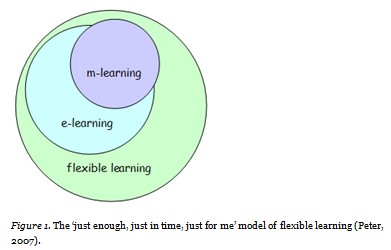
M-learning can provide wireless communication between lecturers and students and between students themselves. It can work as additional support to complement and add value to existing learning models (Motiwalla, 2007). In addition, it is expected to become one of the most effective ways of delivering higher education materials in future (El-Hussein & Cronje, 2010).
Mobile learning applications have been utilized in university teaching and learning settings. Cavus and Ibrahim (2009) investigated the ability of learning new English language words using short message service (SMS). Wu et al. (2012) designed a context-aware mobile learning system for nursing training courses. The aim of the learning system is to guide nursing students to practice a physical assessment including gathering patient symptoms, identifying disease, and providing nursing treatment.
There are several issues facing the adoption of m-learning, and there are pedagogical issues regarding the use of mobile devices in classrooms; will it disturb the learning process? (Corbeil & Valdes-Corbeil, 2007; Park, 2011). Also, will users (both students and lecturers) adopt this technology? Users may not be willing to accept m-learning (Wang, Wu, & Wang, 2009). In addition, some university lecturers do not want to apply this technology or might face difficulties in trying to use it effectively as this new technology may require a lot of effort to implement (Abu-Al-Aish, Love, & Hunaiti, 2012).
Students’ perceptions of m-learning need to be investigated at the initial step of implementing m-learning in higher education (Cheon et al., 2012). Therefore, it is necessary to conduct research that identifies the factors university students consider important in the acceptance of m-learning. Some studies have investigated the acceptance of m-learning using technology acceptance models (Wang, Wu, & Wang, 2009; Park et al., 2011; Liu, Li, & Carlsson, 2010). However, no study has investigated the influence of university lecturers and the quality of m-learning service on students’ behavioral intention to adopt m-learning. Furthermore, students’ confidence with mobile device technologies affects their acceptance of m-learning. Therefore, there is a need to clarify the effect of mobile devices experience on the acceptance of m-learning. Students might need training in the basic functions and applications of m-learning technologies (Cheon et al., 2012).
The objective of this study was to investigate the factors influencing university students’ acceptance of m-learning and to point out if prior experience of mobile device differences affects university students’ acceptance of m-learning.
A number of models have been developed to examine individuals’ acceptance and intention to adopt new technologies in the world of information systems. Davis (1989) tried to determine what causes people to accept or reject information technology. The most widely used model in the field of technology adoption is the technology acceptance model (TAM) (Davis, 1989). The idea of TAM is to give a theoretical basis to explain the impact of external variables (i.e., objective system design characteristics, training, computer self-efficacy) on internal beliefs, attitude toward use, behavioral intentions, and actual system use (Ibrahim & Jaafar, 2011).
Another popular and recent model in information technology acceptance is the unified theory of acceptance and use of technology (UTAUT). This theory was proposed by Venkatesh et al. (2003) and attempts to integrate and empirically compare elements from different technology acceptance models in technology acceptance.
The UTAUT contains four determinants of IT user behaviour and four moderators that are found to moderate the effect of the four determinants on the behaviour intention and user behaviour. UTAUT theorizes that performance expectancy, effort expectancy, social influence, and facilitating conditions are direct determinants of behaviour intention or user behaviour. This gives appreciable improvement to the explanatory power of the model. Also the moderating variables (gender, age, experience, and voluntariness of use) are very important in understanding the characteristics of different user groups (see Figure 2).
Venkatesh et al. (2003) indicate that UTAUT has the ability to explain about 70% of variance in the intention. It has been shown that UTAUT outperforms the previous models (Venkatesh et al., 2003). In addition, it can provide a useful tool for managers to assess the success of the new technology (Ibrahim & Jaafar, 2011).
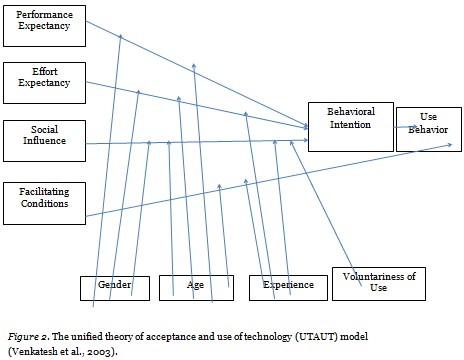
Several studies addressed the factors that affect students’ acceptance of m-learning. Table 1 provides some studies on m-learning acceptance using UTAUT. The results indicate that student’s acceptance of m-learning is key in designing a successful m-learning system. Therefore, there is a need to investigate the factors that affect their acceptance of m-learning and to overtake all challenges that face the success of the factors.
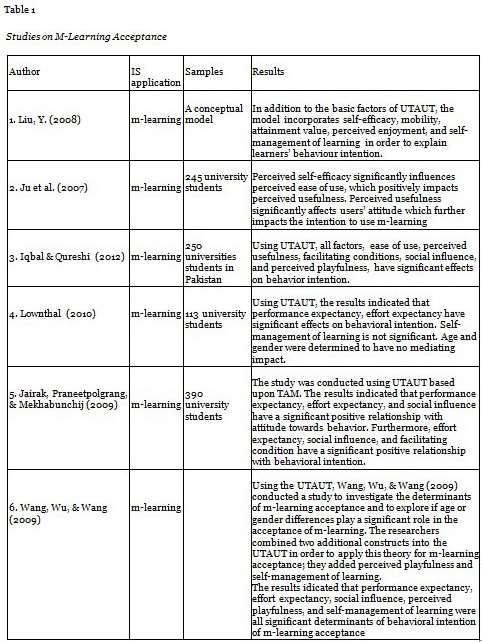
Using the UTAUT, Wang, Wu, and Wang (2009) conducted a study to investigate the determinants of m-learning acceptance and to explore if age or gender differences play a significant role in the acceptance of m-learning. The researchers combined two additional constructs into the UTAUT in order to apply this theory for m-learning acceptance; they added perceived playfulness and self-management of learning.
The results indicated that performance expectancy, effort expectancy, social influence, perceived playfulness, and self-management of learning were all significant determinants of behavioral intention of m-learning acceptance.
After considering the factors that might affect users’ acceptance of m-learning we combined two additional constructs into UTAUT in order to investigate the factors that might affect university student acceptance of m-learning: quality of service and personal innovativeness. In addition, we oriented the social influence construct in UTAUT to explore the lecturers’ influence on behavioral intention. There is no implementation of m-learning in Brunel University. The learning management system in Brunel University offers a series of online courses that can be accessed via Blackboard. Therefore, this study attempted to investigate the effect of the above constructs on behaviour intention to use m-learning. (Use behaviour and facilitating conditions were not investigated in the study.) As a majority of students fall within the same age and a high percentage of them are males, we did not test for the effect of age and gender. Also, as we investigated the acceptance of m-learning in a voluntary usage context, voluntariness of use was eliminated. However, we tested if mobile devices experience would moderate the influence of these factors on behavioral intention. The research model to be tested in this study is shown in Figure 3.
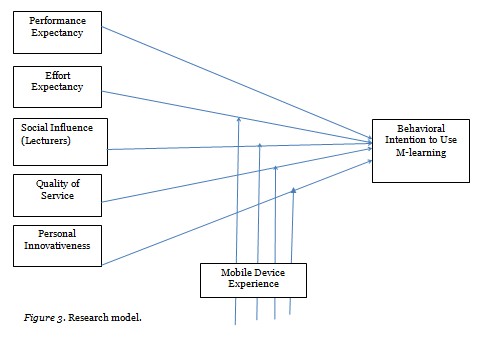
In this section we will discuss the constructs of the proposed model.
Venkatesh et al. (2003) defined performance acceptance as the extent to which a person believes that using an information system would help him or her to benefit in terms of job performance. They also arranged five constructs from the previous models that refer to performance expectancy: perceived usefulness (TAM/TAM2 and C-TAM-TPB), extrinsic motivation (MM), job-fit (MPCU), relative advantage (IDT), and outcome expectations (SCT). In addition, they also indicated that performance expectancy in each previous model is the strongest predictor of behavioural intention to use IT. Davis (1989) demonstrated that perceived usefulness is the most frequent factor used to decide a higher or lower adoption rate. Applying performance expectancy to an m-learning context proposes that students will find m-learning useful because they learn at their convenience and quickly. It will also improve their learning productivity (Wang, Wu, & Wang, 2009). This research attempted to study which performance expectancy of m-learning will influence student behavioural intention to use m-learning. This led to testing the following hypothesis:
H1: Performance expectancy will have a positive effect on behavioural intention to use m-learning.
Venkatesh et al. (2003) defined effort expectancy as the degree of ease that individuals think they will have when using an information system. The three constructs from the previous models that relate to the concept of effort expectancy are perceived ease of use (TAM/TAM2), complexity (MPCU), and ease of use (IDT). This means that the ease of use of a designed information system is one of the key factors of accepting information technology (Wu, Tao, & Yang, 2008). Prior research suggests that individuals’ expectations of system use might be different because of gender, age, and experience. Researchers support the idea that concepts related to effort expectancy will be stronger determinants of individual intention for women (Venkatesh & Morris, 2000; Venkatesh, Morris, & Ackerman, 2000; Vankatesh et al., 2003), particularly those who are older (Morris & Vankatesh, 2000) and who have little experience with the system (Venkatesh et al., 2003). Based on UTAUT, it was expected that students’ acceptance of an m-learning system would depend on whether or not it is easy to use. Therefore, it is hypothesized:
H2: Effort expectancy will have a positive effect on behavioural intention to use m-learning.
Lecturers’ influence is derived from social influence, which is defined as the extent to which a person perceives it is important that others believe he or she should use the new information system (Venkatesh et al., 2003). Prior studies indicate that social influence is a direct determinant of an individual’s behavioural intention to use new technology (Mathieson, 1991; Moore & Benbasat, 1991; Thompson, Higgins, & Howell, 1991; Harrison, Mykytyn, & Riemenschneider, 1997; Venkatesh & Davis, 2000). Social influence was divided into two dimensions: superior influence and peer influence (Igbaria, Schiffma, & Wieckowski, 1994). This study incorporates one critical aspect of (superior) social influence and examines its effect on students’ acceptance of m-learning. In this study, superior influence refers to the lecturers’ influence, which is defined as the extent to which immediate faculty members or instructors directly encourage or motivate their students to use m-learning services. Several studies indicate that supervisors influence a person’s acceptance, both in terms of usage (Igbaria, Schiffman, & Wieckowski, 1994; Karahanna & Straub, 1999) and in terms of communication (Leonard-Barton & Deschamps, 1988). Lecturers’ influence is an important construct to encourage students to adapt new technologies in their learning setting. This led to testing the following hypothesis:
H3: Lecturers’ influence has a positive effect on behavioural intention to use m-learning.
Many research studies in human computer interaction (HCI) (Nielson, 1993; Kuan, Vathanophas, & Bock, 2003) and usability research (Delon & McLean, 1992; Rai, Lang, & Welker, 2002) define quality of service in terms of reliability and response, content quality, and security. The majority of definitions of quality of service have concentrated on customers’ perception of and their satisfaction with the services being offered. Parasuraman, Zeithaml, and Berry (1988) defined consumer expectation of quality of service as what they think a service provider should offer rather than what they would offer. Zeithaml (1988) defined quality of service as users’ assessment of the overall superiority of the service. The excellence of services being provided to users can affect the level of acceptance of new technology (Xin, 2004). Lee (2010) indicated that students’ perception of online support service quality might be considered as a key factor affecting their behavioural intention towards the acceptance of e-learning. Thus this study tested the following hypothesis:
H4: Quality of service has a positive effect on behavioural intention to use m-learning.
Agarwal and Prasad (1998) define it as the individual’s willingness to try out any new information technology. IDT suggests that individuals with a high level of innovativeness are more willing to adopt positive ideas and changes in new IT and have more capacity to deal with uncertainty compared with those with a lower level (Lu, Yao, & Yu, 2005). If individuals are more likely to try new IT, then they can act as change agents and opinion leaders for new IT implementation in organizational settings (Agarwal & Prasad, 1998). Several studies investigated the effect personal innovativeness has on a new IT behavioural intention (Hung & Chang, 2005; Lu, Yao, & Yu, 2005; Lian & Lin, 2008; Fang, Shao, & Lan, 2009). For the adoption of mobile technology in a learning context, most students do not have much experience or knowledge to help them form a clear perception belief. It was expected that students with high personal innovativeness would be more risk taking and have a more positive intention to use m-learning in their study. Therefore the following hypothesis was tested:
H5: Personal innovativeness has a positive effect on behavioural intention to use m-learning.
The questionnaire consisted of 26 items measuring six constructs. The items were derived from different research areas and were adapted to orient them to an m-learning context. This study used a convenience sample technique to collect the data (Creswell, 2012). The questionnaire was distributed to second year students in the School of Information, Computing and Mathematical Science, Brunel University. Students from different classes were invited to participate and complete the questionnaire in their class. A brief description about the research objectives and a definition of m-learning were given by the researcher before students completed the questionnaire.
A total number of 183 responses were obtained. Nine questionnaires were discarded due to being incomplete or containing unreliable answers. We report data from 174 participants. The characteristics of the participants are shown in Table 2.
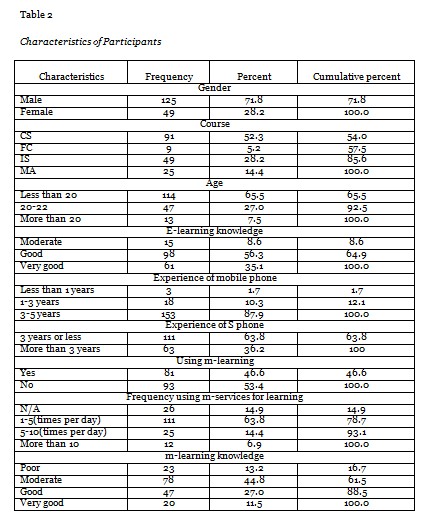
The data analysis method consisted of two steps. Step one contained the assessment of the measurement model to examine if the model is a good fit with the data collected, based on the satisfactory results (i.e., after the construct reached the required measurement standard). We then could proceed to step two (structural model) with hypothesis testing.
An exploratory factor analysis was conducted at the beginning of the analysis using principal components extraction with varimax rotation to extract six factors using SPSS 16. Confirmative factor analysis was then conducted using AMOS 16 to assess the measurement model in terms of factors loading, reliability of measures, convergent validity, and discriminant validity.
Convergent validity can be evaluated using three criteria recommended by Fornell and Larcker (1981): (1) Factor loading greater than 0.50 were considered highly significant; (2) composite reliability should be greater than 0.8; (3) average variance extracted should exceed 0.5.
As shown in Table 3 the results indicate that all items fit their respective factors quite well. All the factor loadings are above the threshold of 0.50. Three items, including items PE4, QoS3, and QoS5, were eliminated due to its standardized factor loadings value, which was less than 0.50. The Cronbach’s alpha values range from .718 to .847, which are all over the .7 level. The composite reliability values (CR) were above 0.8 and the average extracted variances (AVE) were all above the recommended .5 level, thereby indicating good internal consistency (Fornell & Larcker, 1981).

To examine the discriminant validity this study compared the square root of the average variance extracted for each construct and the correlation between this construct and any other construct (Fornell & Larcker, 1981). If the square root of the AVE of a construct is greater than the off diagonal elements in the corresponding rows and columns, this reveals that each construct is more closely related to its own measurements than to those of other constructs (Fornell & Larcker, 1981). As shown in Table 4, the square roots of the AVE of all constructs are greater than the correlation estimate with the other constructs. In summary, the measurement model exhibits adequate reliability, convergent validity, and discriminant validity.
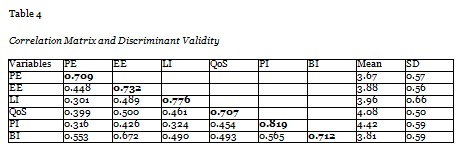
The bold numbers on the diagonal represent the square root of AVE; off-diagonal elements are the correlation estimates. Correlation is significant at the 0.01 level (2-tailed).
Before testing the hypothesis, the maximum likelihood method was used to conduct the analysis through obtaining a number of goodness of fitness indices for the model fitness; the early model-fit indices showed that chi square (χ2) value was 22.65 (df = 10, p = 0.012), comparative fit index (CFI) was 0.38, and the root mean square residual (REMSA) was 0.26, which indicate poor-fit indices, and there is room for refinement. After checking the modified indices positive correlations were created between independent variables to enhance the study model.
The overall goodness-of-fit were examined at another time and achieved the following results. Table 5 shows model-fit indices as well as the recommended thresholds.

As shown in Table 5, all model–fit indices exceeded their respective common acceptance level, as suggested by previous research. We proposed to examine the path coefficient of the structure model. Table 6 shows the presentation of the results of the model testing, including the standardized regression coefficient and the critical ratio. The model tested in this study accounted for 55.0% of behavioral intention to use m-learning.
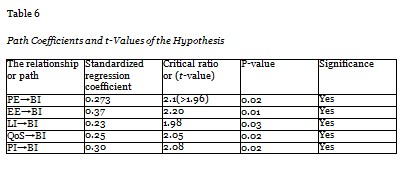
We continue to find the effect students’ prior experience of mobile devices as moderators in the acceptance of m-learning.
To explore the experience differences, we divided the survey respondents into two groups: group one with three years or less experience and group two with more than three years’ experience. Having established an acceptable model fit for both groups, the next step was to run the multiple group covariance analysis. The estimates (coefficients) output and critical ratio (t-value) are reported in Table 7.
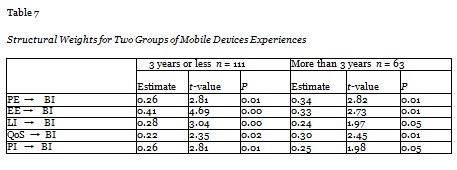
As indicated in Table 7, the structural weights for the first experience group (i.e., three years experience or less) were statistically significant for all links in the model PE-BI. For EE-BI, LI-BI, QoS-BI, and PI-BI (P < 0.05), the structural loading values were 0.26, 0.41, 0.28, 0.22, and 0.26, respectively.
On the other hand, for the second group (i.e., more than three years’ experience), the structural weights for the PE-BI, EE-BI, LI-BI, QoS-BI, and PI were all statistically significant (P < 0.05), and the structural loading values were 0.34, 0.33, 0.24, 0.30, and .25, respectively.
The results indicate that the proposed model adequately explains and has the ability to predict student behavioral intention to adopt m-learning. Performance expectancy, effort expectancy, lecturers’ influence, quality of service, and personal innovativeness were all significant determinants of behavioral intention to adopt m-learning. In addition, the two suggested constructs (quality of service and personal innovativeness) were significant for all students responses (β= 0.25, P < 0.05 and β= .30, P < 0.05, respectively).
Consistent with previous research in the field of technology acceptance, performance expectancy and effort expectancy have a significant, positive influence on behavioral intention to use m-learning (Venkatesh et al., 2003; Jairak, Praneetpolgrang, & Mekhabunchij, 2009; Wang, Wu, & Wang, 2009). The results of this study supports this. Performance expectancy was found to be significant on behavioral intention to use m-learning (Wang, Wu, & Wang, 2009; Chong et al., 2011). It seems that students with high performance expectancy (who believe that using an m-learning system will be beneficial to them in their studies) have a tendency to accept m-learning rather than students with lower performance expectancies.
Effort expectancy was also proven to be a significant influence on student intention to use m-learning (Wang, Wu, & Wang 2009; Chong et al., 2011; Liu, Li, & Carlsson, 2010). The results of the study indicate that effort expectancy was the strongest predictor of behavioral intention to use m-learning (β = 0.37). This result means that students think that the m-learning system will be easy to use and they will not need a lot of instruction on how to use it. This gives an indicator to m-learning designers to provide higher education with easy to operate and user friendly m-learning applications (Wang, Wu, & Wang, 2009).
Lecturers’ influence was found to have a significant effect on behavioral intention to use m-learning. As the study investigates the acceptance of m-learning in universities the researchers explored the effect of social influence from the lecturers’ perspective. Lecturers’ acceptance, and their attitude toward m-learning, will affect their students’ idea about this new technology and will motivate them to adopt it (or not). This is in agreement with previous research results (Igbaria et al., 1996; Karahanna & Straub, 1999).
Quality of service was also found to be a significant influence on behavioral intention to adopt m-learning as students will be willing to adopt an m-learning system when the quality of service provided is seen as being good and beneficial for their studies. This supports the findings of Agarwal et al. (2007), Chong et al. (2011), and Park et al. (2011).
Personal innovativeness, which refers to the individual willingness to adopt new technology, was also found to have a significant influence on behavioral intention to use m-learning. This could suggest an effective strategy to motivate students with high innovativeness at the early stage of the adoption of m-learning, as it has a positive affect on performance expectancy and effort expectancy (Zampou et al., 2012; Liu et al., 2010).
The results indicate that there exist significant experience differences in terms of the effects of the constructs on behavioral intention. Students’ experience of mobile devices moderates the effects of effort expectancy, lecturers’ influence, quality of service, and personal innovativeness on behavioral intention. The results also showed that effort expectancy, lecturers’ influence, and personal innovativeness are stronger predictors of m-learning acceptance for students with three years or less of mobile devices experience than for students with more than three years of mobile devices experience. This is in agreement with Vankatesh et al. (2003) who found that effort expectancy and social influence will influence the behavioral intention for IT usage more at an early stage of experience. However, quality of service was found to be a stronger determinant for the second group (more than three years of experience) than for the first group (three years or less of mobile devices experience).
This study has some limitations that create opportunities for future research. First, this study did not include the actual use of m-learning in the proposed model. Therefore, students’ responses have been biased towards their thoughts about m-learning, and their perception might change over time as they gain experience of actually using an m-learning system or application. Thus, future research needs to investigate the perception of students who have actually been using m-learning in their studies.
Second, the sampling method (i.e., convenience sample) has a potential bias, as all of the participants were within the same age level and were students on the same course. In addition, more male students than female students were willing to participate in the study. Thus the results may be somewhat over representative of the male group and may not be generalizable. Further research might be conducted to investigate the acceptance of m-learning of users from different ages, culture backgrounds, and subjects.
Finally, university lecturers play a significant role in the adoption of m-learning. They can improve their students’ attitude toward m-learning and speed up the implementation of the technology in their departments. Additional research is needed to examine lecturers’ perceptions of m-learning and illustrate what challenges they thought might face the adoption of m-learning in the teaching process.
This study investigated the factors influencing university students’ intention to use m-learning and indicated how mobile devices experience moderates the influence of these factors on behavioral intention. The results show that 55% of the intention to accept m-learning in a higher education context was explained by the proposed model. The study has also showed the applicability of UTAUT in explaining students’ acceptance of m-learning. Furthermore, it extends the UTAUT in the context of m-learning by adding quality of service and personal innovativeness to the structure of UTAUT. The previous conceptual model can be adopted in other educational environments which concentrate on users’ (students and lecturers) behavioral intention to use technologies. It can be utilized to investigate the acceptance of interactive whiteboards, mobile knowledge management learning systems, and learning at the workplace.
It is important for practitioners and university management to motivate students about the benefits of m-learning in university study. Some students with less personal innovativeness might need to be motivated at the initial step of implementing m-learning. In addition, mobile learning designers have to design mobile learning applications that are easy to use and improve students’ performance. The ease of use and usefulness of a mobile learning system can add value to the existing learning management system through improvement of learning and enhancement of students’ acceptance toward m-learning.
Lecturers can promote students’ acceptance of m-learning by adding value to their traditional teaching methods using m-learning. However, lecturers need to be familiar with this new technology and be ready to be involved in the implementation plans. There is a need to motivate university lecturers, increase their awareness of m-learning, and provide them with sufficient training. Furthermore, the quality of service offered by m-learning systems needs to include user-friendliness, meeting of all students’ needs, and up-to-date service as this will attract more students to use m-learning.
In conclusion, the results indicated that higher education institutes need to develop strategic plans and provide guidelines considering students’ acceptance in order to include all critical success factors for the sustainable deployment of m-learning. The results of this study can provide insight into what factors need to be considered for designing an m-learning system in higher education.
We would like to thank our students for their willingness to participate in this study.
Agarwal, R., & Prasad, J. (1998). A conceptual and operational definition of personal innovativeness in the domain of information technology. Information Systems Research, 9(2), 204–215.
Abu-Al-Aish, A., Love, S., & Hunaiti, Z. (2012). Mathematics students’ readiness for mobile learning. International Journal of Mobile and Blending Learning, 4(4), 1-20.
Corbeil, J. R., & Valdes-Corbeil, M. E. (2007). Are you ready for mobile learning? Educause Quarterly, 30(2), 51-58.
Cavus, N., & Ibrahim, D. (2009). m-learning: An experiment in using SMS to support learning new English language words. British Journal of Educational Technology, 40(1), 78-91.
Chong, J., Chong, A., Y, Ooi, K., & Lin, B. (2011). An empirical analysis of the adoption of m-learning in Malaysia. International Journal of Mobile Communication, 9(1), 1-18.
Crawford, V. M. (2007). Creating a powerful learning environment with networked mobile learning devices. Educational Technology Magazine: The Magazine for Managers of Change in Education, 47(3), 47-50.
Creswell, J. W. (2012). Educational research: Planning, conducting, and evaluating quantitative and qualitative research (4th ed.). Upper Saddle River, NJ: Pearson Education.
Davis, F. D. (1989). Perceived usefulness, perceived ease of use, and user acceptance ofinformation technology. MIS Quarterly, 13(3), 319-340.
Delone, W., & Mclean E. (1992). Information systems success: The quest for the dependent variable. Information Systems Research, 3(1), 60-95.
El-Hussein, M. O. M., & Cronje, J. C. (2010). Defining mobile learning in higher education landscape. Educational Technology & Society, 13(3), 12-21.
Fang, J., Shao, P., & Lan, G. (2009). Effects of innovativeness and trust on web survey participation. Computers in Human Behavior, 25, 144–152.
Fornell, C., & Larcker, D. F. (1981). Evaluating structural quation models with unobservable variables and measurement error. Journal of Marketing Research, 18(1), 39-50.
Harrison, D. A., Mykytyn, P. P., & Riemenschneider, C. K. (1997). Executive decisions about adoption of information technology in small business: Theory and empirical tests. Information Systems Research, 8(2), 171–195.
Hung, S. Y., & Chang, C. M. (2005). User acceptance of wap services: Test of competing theories. Computer Standards & Interfaces, 28, 359–370.
Ibrahim, R., & Jaafar, A. (2011). User acceptance of educational games: A revised unified theory of acceptance and use of technology (UTAUT). World Academy of Science, Engineering and Technology, 53, 551-557.
Iqbal, S., & Qureshi, I. A. (2012). m-learning adoption: A perspective from a developing country. The International Review of Research in Open and Distance Learning, 3(3), 147-164.
Igbaria, M., Schiffman, S. J., & Wieckowski, T. J. (1994). The respective roles of perceived usefulness and perceived fun in the acceptance of microcomputer technology. Behaviour & Information Technology, 13(6), 349-361.
Jairak, K., Praneetpolgrang, P., & Mekhabunchakij, K. (2009). An acceptance of mobile learning for higher education students in Thailand. In Proceeding for the 6th International Conference on E-Learning from Knowledge –Based Society, 17-18 December 2009, Thailand.
Ju, T. L., Sriprapaipong, W., & Minh, D. N. (2007). On the success factors of mobile learning. In proceeding for the 5th International Conference on ICT and Higher Education, Bangkok. Retrieved from http://phd- e%20Learning.pdf. it.siam.edu/Conference2007/documents/On%20the%20Success%20Factors%20of%20Mobile%20Learning.pdf
Karahanna, E., & Straub, D. W. (1999). The psychological origins of perceived usefulness and ease-of-use. Information and Management, 35, 237-250.
King, W., & He, J. (2006). A meta-analysis of the technology acceptance model. Information and Management, 43(2006), 740-755.
Kuan, H., Vathanophas, V., & Bock, G. (2003). The impact of usability on the intention of planned purchases in e-commerce service websites. 7th Pacific Asia Conference on Information Systems, 10-13 July 2003, Adelaide, South Australia. Retrieved from http://www.business.ecu.edu.au/users/cstanding/Stuff/Usability%20paper.pdf
Lee, J. W. (2010). Online support service quality, online learning acceptance, and student satisfaction. The Internet and Higher Education, 13(4), 277-283.
Leonard-Barton, D., & Deschamps, I. (1988). Managerial influence in the implementation of new technology. Management Science, 31(10), 1252-1265.
Lian, J., & Lin, T. (2008). Effects of consumer characteristics on their acceptance of online shopping: Comparisons among different product types. Computers in Human Behavior, 24(1), 48–65.
Liu, Y. (2008). An adoption model for mobile learning. In Proceeding for the IADIS International Conference e-Commerce. Amsterdam, Netherlands
Liu, Y., Li, H., & Carlsson, C. (2010). Factors driving the adoption of m-learning: An empirical study. Computers & Education, 55(3), 1211-1219.
Lowenthal, J. (2010). Using mobile learning: determinates impacting behavioral intention. The American Journal of Distance Education, 24(4), 195-206.
Lu, J., Yao, J. E., & Yu, C. S. (2005). Personal innovativeness, social influences and adoption of wireless Internet services via mobile technology. Journal of Strategic Information Systems, 14(3), 245–268.
Mathieson, K. (1991). Predicting user intentions: comparing the technology acceptance model with the theory of planned behavior. Information Systems Research, 2(3), 173–191.
Moore, G. C., & Benbasat, I. (1991). Development of an instrument to measure the perceptions of adopting an information technology innovation. Information Systems Research, 2(3), 192–222.
Morris, M. G., & Venkatesh, V. (2000). Age differences in technology adoption decisions: Implications for a changing workforce. Personnel Psychology, 53(2), 375–403.
Motiwalla, L. F. (2007). Mobile learning: A framework and evaluation. Computer & Education, 49(3), 581-596.
Naismith, L., & Corlett, D. (2006). Reflections on success: A retrospective of the mLearn conference series 2002-2005. In Proceedings of mLearn 2006 – the 5th World Conference on m-learning.
Nassuora, A. B. (2012). Students acceptance of mobile learning for higher education in Saudi Arabia. American Academic & Scholarly Research Journal, 4(2).
Nielsen, J. (1993). Usability engineering. San Francisco: Morgan Kaufman.
Parasuraman, A., Zeithaml, V. A., & Berry, L. L. (1988). SERVQAL: A multiple item scale for measuring consumer perceptions of service quality. Journal of Retailing, 64(4), 35-48.
Park, Y. (2011). A pedagogical framework for mobile learning: Categorizing educational applications of mobile technologies into four types. International Review of Research in Open and Distance Learning, 12(2), 78-102.
Park, S. Y, Nam, M., & Cha, S. (2011). University students’ behavioral intention to use mobile learning: Evaluating the technology acceptance model. British Journal of Education Technology, 43(4), 592-605.
Rai, A., Lang, S., & Welker R. (2002). Assessing the validity of IS success models: An empirical and theoretical analysis. Information Systems Research, 13(1), 50-69.
Thompson, R. L., Higgins, C. A., & Howell, J. M. (1991). Personal computing: Toward a conceptual model of utilization. MIS Quarterly, 15(1), 124–143.
Venkatesh, V., & Davis, F. D. (2000). A theoretical extension of the technology acceptance model: four longitudinal field studies. Management Science, 45(2), 186–204.
Venkatesh, V., & Morris, M. G. (2000).Why don’t men ever stop to ask for directions? Gender, social influences, and their role in technology acceptance and usage behavior. MIS Quarterly, 24(1), 115–139.
Venkatesh, V., Morris, M. G., & Ackerman, P. L. (2000). A longitudinal field investigation of gender differences in individual technology adoption decision making processes. Organizational Behavior and Human Decision Processes, 83(1), 33–60.
Venkatesh, V., Morris M. G., Davis, G. B., & Davis, F. D. (2003). User acceptance of information technology: Toward a unified view. MIS Quarterly, 27(3), 425-478.
Wang, Y., Lin, H., & Luarn P. (2006). Predicting consumer intention to use mobile service. Information Systems Journal, 16, 157-179.
Wang, Y., Wu, M., & Wang, H. (2009). Investigating the determinants and age and gender differences in the acceptance of mobile learning. British Journal of Educational Technology, 40(1), 92-118.
Wu, P.-H., Hwang, G.-J., Su, L.-H., & Huang, Y.-M. (2012). A context-aware mobile learning system for supporting cognitive apprenticeships in nursing skill training. Educational Technology & Society, 15(1), 223–236.
Wu, Y., Tao, Y., & Yang, P. (2008). The use of unified theory of acceptance and use of technology to confer the behavioral model of 3G mobile telecommunication users. Journal of Statistics & Management Systems, 11(5), 919-949.
Xin, X. (2004). A model of 3g adoption. AMCIS 2004 Proceedings Paper 320.
Zeithaml, V.A. (1988). Consumer perceptions of price, quality, and value: a means-end model and synthesis of evidence. Journal of Marketing, 52(3), 2–22.
Performance Expectancy (PE)
PE1. I find m-learning useful for my studies.
PE2. Using m-learning would enable me to achieve learning tasks more quickly.
PE3. Using m-learning in my studying would not increase my learning productivity.
PE4. Mobile learning could improve my collaboration with classmates.
PE5. Using m-learning would not improve my performance in my studies.
Effort Expectancy (EE)
EE1. I would find an m-learning system flexible and easy to use.
EE2. Learning to operate an m-learning system does not require much effort.
EE3. My interaction with an m-learning system would be clear and understandable
EE4. It would be easy for me to become skillful at using an m-learning system.
Lecturers’ Influence (LI)
LI1. I would use m-learning if it was recommended to me by my lecturers.
LI2. I would like to use m-learning if my lecturers’ supported the use of it.
LI3. Lecturers in my Department have not been helpful in the use of m-learning systems.
Quality of Services (QoS)
QoS1. It is important for m-learning services to increase the quality of learning.
QoS2. I would prefer m-learning services to be accurate and reliable.
QoS3. It is not important for m-learning services to be secure to use.
QoS4. It is important for m-learning to focus on the speed of browsing the internet and obtaining information quickly.
QoS5. Communication and feedback between lecturers and students would not be easy.
using m-learning systems.
QoS6. It is preferable that m-learning services are easy to navigate and download.
Personal Innovativeness (PInn)
PInn1. I like to experiment with new information technologies.
PInn2. When I hear about a new information technology I look forward to examining it.
PInn3. Among my colleagues, I am usually the first to try out a new innovation in technology.
Behavioural Intention (BI)
BI1. I plan to use m-learning in my studies.
BI2. I predict that I will use m-learning frequently.
BI3. I intend to increase my use of mobile services in the future.
BI4. I will enjoy using m-learning systems.
BI5. I would recommend others to use m-learning systems.